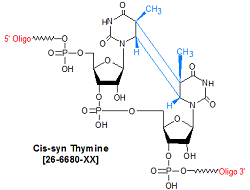
Modification : Thymine Dimer Cis-syn
Catalog Reference Number
Category
Modification Code
5 Prime
3 Prime
Internal
Molecular Weight (mw)
Extinction Coeficient (ec)
Technical Info (pdf)
Absorbance MAX
Emission MAX
Absorbance EC
| Catalog No | Scale | Price |
| 26-6680-05 | 50 nmol | $2,786.00 |
| 26-6680-02 | 200 nmol | $2,786.00 |
| 26-6680-01 | 1 umol | $3,964.00 |
| 26-6680-03 | 2 umol | $5,551.00 |
| 26-6680-06 | 5 umol | $17,838.00 |
| 26-6680-10 | 10 umol | $20,045.00 |
| 26-6680-15 | 15 umol | $24,054.00 |
| Discounts are available for Thymine Dimer Cis-syn ! |
| Modification* Discount Price Structure |
|
1 site/order
|
List price
|
|
2 sites/order
|
10% discount
|
|
3 sites/order
|
20% discount
|
|
4 sites/order
|
30% discount
|
|
5-9 sites/order
|
50% discount
|
|
10+ sites/order
|
60% discount
|
|
*Exceptions apply
|
Cis-syn thymine is classified as a cis-syn Cyclobutane Pyrimidine Dimer (CPD) of two thymine bases, and is primarily used in studies of UV-induced DNA damage and associated repair mechanisms. In the cell, cis-syn thymine dimer DNA lesions are primarily formed when two adjacent thymidine bases are irradiated by UV light (most commonly from sunlight). The result is the generation of a dimer in the form of a cyclobutane (1). This bulky adduct lesion causes large structural distortion in the double helix. While not mutagenic, they act as effective replication blocks; as such, they are potentially lethal to the cell (2). This lesion is repaired via one of two repair DNA repair mechanisms: direct reversal with the enzyme photolyase (which cleaves the dimer) (3) or by the nucleotide excision repair (NER) mechanism (4).
Oligos synthesized with cis-syn thymine dimer are stable for greater than 6 month when stored frozen, protected from light and preferably in an ethanol precipitated dried state. Reconstituted oligos should be preferably stored frozen in aliquots to avoid multiple freeze thaw cycles.
References
1. Smith, C.A., Taylor, J-S. Preparation and characterization of a set of deoxyoligonucleotide 49-mers containing site-specific cis-syn, trans-syn-l, (6-4), and Dewar photoproducts of thymidylyl(3' to 5')-thymidine. J. Biol. Chem. (1993), 268: 11143-11151.
2. Gentil, A., Le Page, F., Margot, A., Lawrence, C.W., Borden, A., Sarasin, A. Mutagenicity of a unique thymine-thymine dimer or thymine-thymine pyrimidine pyrimidone (6-4) photoproduct in mammalian cells. Nucleic Acids Res. (1996), 24: 1837-1840.
3. Sancar, A. Structure and function of DNA photolyase and cryptochrome blue-light photoreceptors.Chem. Rev. (2003), 103: 2203-2237.
4. de Laat, W.L., Jaspers, N.G.J., Hoeijmakers, J.H.J. Molecular mechanism of nucleotide excision repair. Genes & Development. (1999), 13: 768-785.
- Cis-syn Thymine Dimer Cyclobutane Pyrimidine Dimer (CPD)
